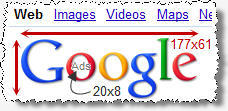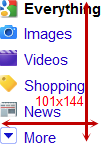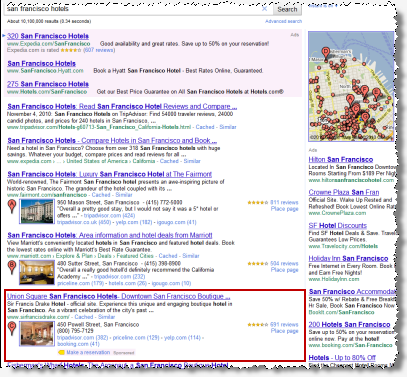
Google's tiny "Ads" label (just 20x8 pixels) substantially fits within the "o" of "Google".
 |
69x8 79x13 42x13 93x8 |
| actual ("color:#767676"): |  |
alternative - simple black: |  |
|
A Closer Look at Google's Advertisement Labels The FTC has called for "clear and conspicuous disclosures" in advertisement labels at search engines, and the FTC specifically emphasized the need for "terms and a format that are easy for consumers to understand." Unfortunately, Google's new advertisement labels fail this test: Google's "Ads" label is the smallest text on the page, far too easily overlooked; Google's algorithmic and advertisement results are merged within a single set of listings; Google's "Help" explanations are inaccurate; and Google uses inconsistent labels mere inches apart within search results, as well as across services. |
Related Projects "Sponsored Links" or "Advertisements"?: Measuring Labeling Alternatives in Internet Search Engines Tying Google Affiliate Network False and Deceptive Pay-Per-Click Ads Google Toolbar Tracks Browsing Even After Users Choose "Disable" |
Disclosure: I serve as a consultant to various companies that compete with Google. But I write on my own -- not at the suggestion or request of any client, without approval or payment from any client.

 |
69x8 79x13 42x13 93x8 |
| actual ("color:#767676"): |  |
alternative - simple black: |  |
On the whole, there has been little discussion of the purpose of this change. Google confirmed the change in a statement to Search Engine Land but offered no explanation of the change's purpose or intention. Thenextweb suggested that Google "must have tested ... 'Ads' versus 'Sponsored links' and found that 'Ads' [performed] better", while Paid Content hypothesized that either "Ads" gets more clicks, or Google is planning on advertisements that go beyond links. Meanwhile, my colleague Joshua Gans found Google's move to "Ads" an example of "not being evil", suggesting that "Ads" may offer a more effective disclosure than the predecessor "Sponsored links".
When I evaluate disclosures, I tend to look at the two factors specified by FTC precedent: disclosures should be both "clear" and "conspicuous." I think Gans is right to classify "Ads" as more clear than "Sponsored links." But it's still far from perfect. Google's own Definitions service offers "short form of advertisement" as the ninth definition of "ad"; the first eight definitions all refer to other concepts. And none of Google's definitions of "ads" pertain to advertising. American speakers of English tend to know what "ads" are, but British speakers tend to favor "advert" and might not even recognize "ad" as shorthand for "abbreviation."
On net, I do view "Ads" as an improvement over the prior label "Sponsored links", but the improvement largely results from the low starting point. As Duncan Gilchrist and I point out in "Sponsored Links" or "Advertisements"?: Measuring Labeling Alternatives in Internet Search Engines, the label "Sponsored links" uses passive voice, strikingly unclear as to who exactly is "sponsor[ing]" a link or what that even means. (As we note in the paper, multiple prior studies flagged these problems with the "Sponsored link" label, using diverse methodologies ranging from legal analysis to interviews and ethnography.) So "Ads" offers at least some improvement in disclosure clarity.
However, the FTC instructs evaluating not only whether a disclosure is clear, but also whether it is conspicuous. On that front, I believe Google's "Ads" label falls importantly short. For one, the "Ads" label is absolutely tiny: It measures just 20 pixels wide by 8 pixels tall, a total of 160 pixels of display area. Compare the various other page elements shown at right -- even the small "Instant is on" label more than three times as large as "Ads". Indeed, as I show in the top-most image at right, Google's "Ads" label substantially fits within the "o" of "Google"! Combine the label's small size with its placement at the extreme corner of results, and the label is the very opposite of "conspicuous."
Google's "Ads" label is also less conspicuous by reason of its color. Using CSS, Google sets the "Ads" disclosure to "color:#767676" -- a mid-range grey, about halfway between pure black (#000000) and pure white (#FFFFFF). A simple black label, in the same font size, would be strikingly more noticeable. Compare the bottom two images at right. The second image, showing the "Ads" label in simple black, is taken from a screenshot I prepared after manually adjusting CSS to replace #767676 with #000000. The darker text takes up no additional space, but it offers higher contrast against the white background -- hence more noticeable and easier to read.
I believe the informality of the colloquial "Ads" also deemphasizes the importance of the disclosure. Using an informal term suggests that the label is a casual matter, when in fact is a crucial disclosure required by law. A formal label written in full and formal words, for example, "Paid Advertisement", would better convey the seriousness of the disclosure. Indeed, prior FTC litigation has systematically sought the label "paid advertisement." (See e.g. FTC v. Michael S. Levey, et al.; Proposed Consent Agreement with Analysis to Aid Public Comment. 58 FR 38764 (1993).)
I notice that plenty of space remains for a full label "Paid Advertisements" or at least "Advertisements." If Google's true goal is to inform users -- not just to increase advertisement clicks, as blogs have speculated -- Google should adopt nothing less than "Paid Advertisement."
Google's new search layouts mix algorithmic and advertisement results

I am also concerned to see various new Google search layouts that intersperse algorithmic and advertisement results. For years, search engines have taken steps to separate these areas to assist users in understanding the important differences between algorithmic results versus advertisements. But Google's new designs muddy the waters.
As shown in the image at right, Google's advertisement listings can now appear midway through left-side listings, an area traditionally reserved for algorithmic links. See the Sir Francis Drake Hotel listing in the red box at right, a listing Google presents as "Sponsored." By comingling advertisements among algorithmic results, Google blurs the boundaries between these categories -- reducing the separation between these categories. I note that these problems are not short-term errata resulting from Google's November 2010 layout adjustments; to the contrary, Figure 14 shows a layout that has run for at least 7 months. (Search Engine Land prepared a screenshot showing similar problems in February 2010.)
Google's new layout of maps and pushpins also blurs the separation between algorithmic results and advertisements through by placing a map at top-right, an area traditionally occupied by advertisements. This design invites users to look back and forth between the algorithmic area and the traditional advertising area, further blurring the boundary between these sections. Furthermore, in all my searches to date, the map's legend entries largely appear within algorithmic results, just as they do in the image at right. So I struggle to see why Google places the map in a portion of the screen where, for more than a decade, Google has only shown advertisements.
Wherever and however Google places advertisements, Google's help pages must be in accord. Yet see Google's Search Basics help page continues to indicate, incorrectly, 1) that the entire right side of the screen presents "sponsored" results, and 2) that no advertisements appear elsewhere in search results. And Google's Our Philosophy page reports, incorrectly, that "advertising on Google is always clearly identified as a 'Sponsored Link'" -- inaccurate today as to listings now labeled "Ads", and inaccurate for months as to "comparison ads" not labeled as Google's statement promises.
Inconsistent labels: "Ads" versus "Sponsored" listings on the very same page!
Google's new use of "Ads" requires updates elsewhere.Although Google now labels top-of-page and side-of-page advertisements as "Ads," Google's paid pushpins are instead labeled "sponsored." (See the red-boxed listing in the screenshot in the preceding section.) A user who sees both "ad" and "sponsored" listings would struggle to figure out whether the terms are interchangeable; even someone who believes "sponsored" results are "ads" may have second thoughts upon seeing Google use both terms on a single page. The solution is clear: Google should use a single label throughout the entire page.
Despite Google's use of "Ads" in ordinary web search results, Google's other properties still show other labels. For example, the screenshot at right shows that Google's mobile search still uses the label "Sponsored Links." Google should adopt a single consistent label across all its services so that users need not learn to interpret multiple inconsistent terms.
The FTC has called for "clear and conspicuous disclosures" in search engine's advertisement labels, and the FTC specifically emphasized the need for "terms and a format that are easy for consumers to understand." I applaud that objective. But Google's current implementation falls short. Indeed, in many respects Google's recent changes have been for the worse.
Google should replace "Ads" with "Paid Advertisements" or another label that is clear, formal, and precise. Google should cease to merge algorithmic and advertisement results in a single list, and Google should be cautious in changing page layout in ways at odds with users' long-held understanding of where advertisements appear. All Google "Help" pages should provide accurate and precise information, and Google services should use consistent labels to aid users in understanding that Google's "Sponsored" "Ads" are in fact paid advertisements.
Throughout, disclosures should be designed to be clear not only to technology professionals and other experts, but also to novices, kids, and those who are distracted or in a rush. I am confident that Google's user interface designers can achieve this high standard, but there's plenty of work to do.
Posted: November 10, 2010.
Sign
up for notification of major updates and related work.